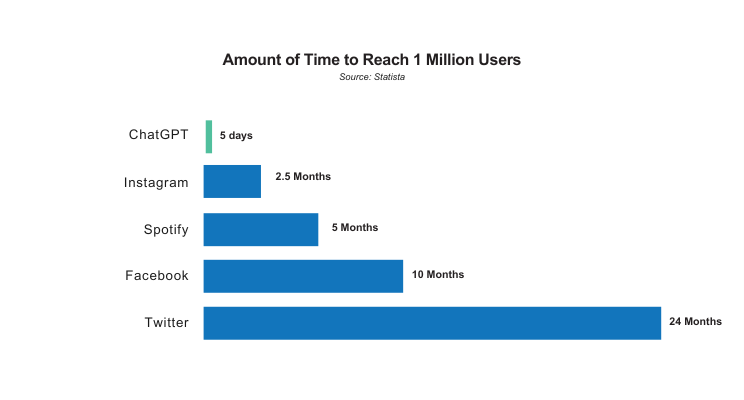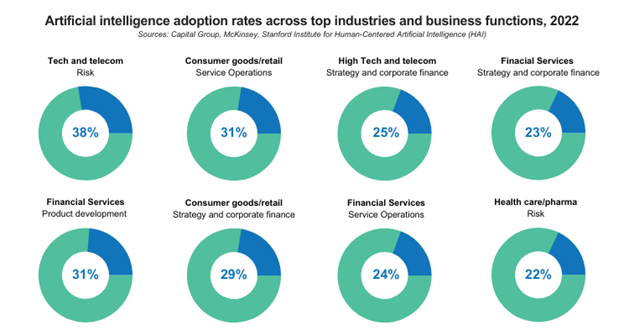It’s hard to ignore the amount of attention artificial intelligence (AI) is getting in the headlines today and the huge advances in technology touching all areas of life. AI is a powerful technology tool with the potential to profoundly shape the future across multiple generations. Given the huge impact this technology could have on our lives, the economy, and the investment landscape we wanted to address this topic in a series of articles.
The first step is to define and explain what AI is. Future articles will cover the economic implications from AI along with expected shifts in the labor force and what, if any, investment opportunities will arise from the rapid adoption of AI technology.
What is Artificial Intelligence?
The term artificial intelligence broadly refers to applications of technology to perform tasks that resemble human cognitive function. It is generally defined as the capability of a machine to imitate human intelligent behavior. The birth of modern artificial intelligence dates to 1956 when Dartmouth professor John McCarthy helped coin the term at an academic conference. McCarthy went on to earn the standing as the father of AI during his long tenure as a computer science professor at Stanford University.
In practice today, AI is used as an umbrella term that encompasses a broad spectrum of different technologies. A few examples of AI you might have heard of include robotics technology (which has been advancing manufacturing tasks for decades with the use of robots on assembly lines), self-driving cars, Apple’s mobile voice assistant Siri, and Amazon’s Alexa cloud-based voice service.
So, what has changed to make us all start talking about AI now and create this huge amount of hype? A significant new development relates to OpenAI which is a for-profit organization originally founded in 2015 by Elon Musk (as a nonprofit) and other prominent Silicon Valley individuals with a $10 billion investment from Microsoft. Its mission is to “ensure that artificial general intelligence – AI systems that are generally smarter than humans – benefits all of humanity.” As part of this mission, OpenAI made its ChatGPT technology available to the public for free late last year.
What is ChatGPT?
ChatGPT is a chatbot built on a large language model that can simulate human-like understanding and produce well-crafted, conversational responses. Yes, ChatGPT is like those annoying customer service chatbots that can never seem to understand why you are calling or get you where you need to go. At the most basic level, a chatbot is a computer program that simulates and processes human conversation (either written or spoken), allowing humans to interact with digital devices as if they were communicating with a real person. However, this version is much more powerful with the ability to improve responses over time, write academic papers and poems, write or check computer code, create music and videos, and generate (generally) appropriate text in response to your written prompt. ChatGPT can’t reason or “think” logically but has the potential to be one of the next transformative technology tools.
Many have termed the late-2022 introduction of ChatGPT an “iPhone moment”. But even the iPhone didn’t break from the gates as fast as ChatGPT which attracted a million users in its first five days and 100 million users within two months – 15 times faster than Instagram. In comparison, Facebook took 10 months to attract a million users and 5 years to reach 100 million users as shown on the chart below:

This potentially transformative technology has created significant hype and makes the future of ChatGPT appear extremely bright. However, to bring us back to reality, the industry consultant Gartner notes that a new technology typically passes through a “hype cycle”. Inflated initial expectations lead to disillusionment before the technology matures to achieve widespread adoption.
The computing power and intellectual framework underlying ChatGPT likely represent the next phase of decades-long development. The current step has led to hardware and software capable of processing massive amounts of data and “learning” through repeated interaction. The “learning” component is a key point – large language models such as ChatGPT are a type of so-called machine learning that uses algorithms and statistical models to analyze data. For years, algorithms have analyzed numerical data to identify patterns and assess probabilities. Large language models can now do the same with text and visual images.
The “GPT” stands for “generative pre-trained transformer”. Generative AI remains in its infancy. There is no “intelligence” in artificial intelligence – it can’t think. It uses algorithms that predictive analytics have employed for the past two decades. So, it’s more evolutionary than revolutionary. The big leaps in AI might occur when machine learning is transformed into what is called deep learning – can a computer eventually reason, make judgements and function like a real human brain? This step is what has participants concerned, even more so given the lack of oversight on the development of existing technology platforms. There are many social, ethical, economical, and security issues related to AI that have not been addressed in this rapidly advancing field.

What are the Limitations of Artificial Intelligence?
Despite its promise to improve productivity by offloading mundane, time-consuming tasks, it’s important to understand ChatGPT’s limitations. For all the comparisons to Google Search, it’s not a search engine. It predicts the most statistically probable next word in a sentence based on previous training and surrounding words. Also, it needs humans to continuously update it with new information and requires feedback loops so that it can learn from its mistakes. Perhaps this is why Bard (Google’s version) and ChatGPT are available to the public for free (or at least the initial versions) so that everyone’s interactions can help “teach” it with the prompts we enter and continue to fine tune to get at our expected results.
One of the major limitations and the biggest threat is the potential for misinformation produced by generative AI. ChatGPT responses can’t provide a linked source to validate their accuracy. Perhaps most concerning, at times, it will respond inaccurately – sometimes wildly so, “hallucinating” with information it deems plausible. Humans must provide guardrails and verify information. When probed to provide sources, there have been instances when it provided inaccurate or nonexistent sources.
A recent study from Stanford University found ChatGPT’s accuracy declined over a short period of time. Over the course of the study, researchers found that in March of this year the latest version of ChatGPT was able to correctly identify that the number 17077 is a prime number 98% of the times it was asked, but three months later its accuracy dropped to less than 3%. Similar varying results occurred when the researchers asked the models to write computer code and when a visual reasoning test asked the technology to predict the next figure in a pattern. The model’s problem of offering answers with varying levels of quality and accuracy has been called “drift”. A main finding of the study proved that drifts do occur and are prevalent in these large language models.
In addition, due to the lack of visibility into how the models powering ChatGPT work, researchers cannot determine the cause of these vastly different outcomes. One suggestion is that when the models are continuously trained to improve performance on certain tasks, it can have unintended consequences, which might hurt the model’s performance on other tasks. The study also reported ChatGPT failed to consistently demonstrate how it came to its conclusions. When asked to lay out its “chain of thought”, the term for when a chatbot explains its reasoning, it provided the information in March but failed to do so in June.
While the limitations of ChatGPT will continue to be studied, the adoption rate across different businesses continues at a rapid pace.
Broader Types of Artificial Intelligence
Beyond ChatGPT, AI applications are being adopted across industries and business functions as shown below:

Globally, companies are expected to spend an estimated $500 billion next year adopting AI technology into their workflows and businesses. Potential uses for AI across healthcare, financial, retail and transportation industries include:
- Healthcare: AI has the potential to curb or eliminate medical mistakes, including prescription errors that result in about a quarter of a million deaths annually in the U.S. An AI tool called DXplain has helped boost the accuracy rates of clinical diagnoses. AI-powered software can analyze X-rays, MRIs or CT scans to help radiologists improve the accuracy rate of their diagnoses. AI could eventually help paralyzed individuals perform day-to-day tasks.
- Financial: First National Bank of Omaha has teamed with AI lending platform provider Upstart to scale its personal loan program across the nation. ChatGPT can be used to “decode” lengthy statements from Federal Reserve officials.
- Retail: Amazon has been deploying a robot called Sparrow since 2015, which picks up items and puts them in shipping boxes. Today Sparrow can pick out roughly two-thirds of the more than 100 million items in an Amazon warehouse at a rate of just seconds per pick.
- Transportation: Self-driving cars and trucks have been gaining real-world traction. Waymo One and Waymo Driver, the driverless car services of Google parent Alphabet and GM’s Cruise, are robo-taxiing passengers – without safety drivers – in Phoenix and San Francisco. Both companies have disclosed plans to launch taxis in more cities.
The recent developments in AI suggest we may be at the start of a cycle that could transform the technology landscape as well as the broader economy.
ChatGPT could do for AI what the Apple App Store did for the iPhone in providing a space for a host of new applications to be created and accessed for the benefit of all users based on their individual needs.
In our next article we will explore the economic impact and possible changes to the labor force created by AI technology. History has shown that for all jobs lost to technological advancement others emerge. Some analysts are predicting a net increase in demand for workers due to AI and an interesting shift in the types of jobs needing to be filled.
Smith + Howard Wealth Management:
As Artificial Intelligence reshapes industries and economies, the potential for smart investments is undeniable.
At Smith + Howard Wealth Management, our team of advisors is available and ready to answer your questions on these or other topics related to Artificial Intelligence. Please call us at 404-874-6244 or email us here.
Unless stated otherwise, any estimates or projections (including performance and risk) given in this presentation are intended to be forward-looking statements. Such estimates are subject to actual known and unknown risks, uncertainties, and other factors that could cause actual results to differ materially from those projected. The securities described within this presentation do not represent all of the securities purchased, sold or recommended for client accounts. The reader should not assume that an investment in such securities was or will be profitable. Past performance does not indicate future results.

 Back to Insights
Back to Insights 